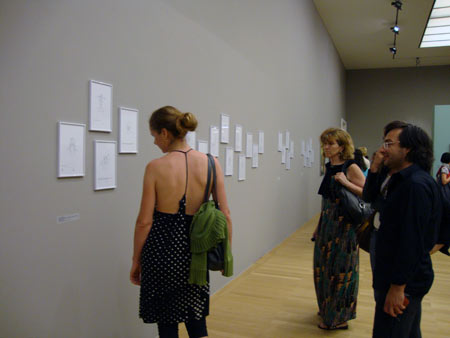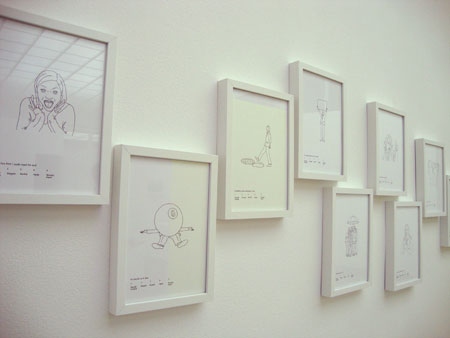The Only Thing I Can Control Is My Attitude Towards Life
Year: 2009
Type: solo exhibition (video, drawings, installation, prints)
Exhibition title: Vesna Bukovec, The Only Thing I Can Control Is My Attitude Towards Life / Edina stvar, ki jo imam pod nadzorom, je moj odnos do življenja
Location: Miklova hiša Gallery, Ribnica, Slovenia
Date: October 1 – 31, 2009
Curated by: Urška Jurman

At this exhibition Vesna Bukovec presents the video It Will Be OK and a series of drawings. Both works deal with the self-help culture and the dictate of positive thought as two cultural formations that importantly form and express the contemporary subjectivity.
An individual is supposed to be (self)fulfilled, happy and successful, with a stable and harmonious identity. There are numerous techniques that will lead us closer to this goal – from therapy, self-help books, Oprah Winfrey shows, to answering various psychological tests, attending various trainings and workshops, to making use of various cosmetic and fashion industries, etc. It is all up to us. Parallel to the increase of control in contemporary society individuals are also supposed to increase control over our own lives.
Vesna Bukovec takes a closer look at psychology, which is worked and distributed through the various forms of popular culture. The use of English language in both works is especially important for it indicates the dominating role of the Anglo-American culture at the dissemination of such instant psychology.
The authoress directs her criticism towards the over simplification of the complexity of our emotions and life circumstances, which – in the context of exaggerated positive orientation (It Will Be OK) and the various psychological tests that she addresses in her drawings – seem as a merely insignificant comment. At this she uses irony, repetition and eclecticism as her artistic strategy, with which she holds a mirror against the absurdity of the narcissistic care of oneself.
The video It Will Be OK shows a woman sitting on a couch, holding a stuffed dog with big sad eyes in her hands. She is trying to cheer up the stuffed dog by stroking it and telling it that ‘it will be OK’. The video is dominated by the white colour, the repetitive positive affirmations and movements, and the static situation emphasised by the tick-tacking sound of the clock in the background. In the video the authoress uses white colour that stands for order, cleanness and innocence as a metaphor for perfection towards which individuals should aspire in the contemporary narcissistic culture. At the same time she transforms the symbol of innocence into a symbol of naivety as the individual believes in the actual fulfilment of the expressed statements. The white colour also indicates the criticalness of the situation – the woman is (neurotically) trying to comfort herself. However, ‘Freud’s couch’ and the revolutionary psychoanalytical ‘talking cure’ are reduced to the scene and empty mantras, the goal of which is to calm and pacify the individual – as indicated also by the exhibition title. If we take the above stated – according to which individuals increase control over their lives for which they have full responsibility – into account it all seems paradoxical. But as we dig deeper into ourselves, deal with our own problems, our engagement in the public (social, political) sphere is reduced. The individual who is fully employed with herself/himself has no time to tackle social issues; while striving for personal growth and happiness she/he is occupied only to the extent, to which she/he could function successfully in the existing social relations. In this sense the emancipating potential of the self-help culture is dubious, for the subjectivity is atomised and emptied of all social and political contents and thus fails to offer appropriate ways in which one could join the public and personal spheres. However, the video offers an even darker image of the conditions – it shows that within the context of overzealous positive life orientation the therapeutic discourse can even mean the lack of actual dealing with one’s own problems and depicts the hopelessness of the situation regardless of the endeavours of the protagonist.
In the series of drawings Vesna Bukovec took texts that she has found in various psychological tests on positive life orientation and placed them in a dialogue with images that she has taken from commercial internet photo archives. The drawings are reduced to simple lines and thus successfully complement the ‘thinness’ of the written statements/questions. The selection of images offers additional irony to the accompanying texts, the effect of which is emphasised by the en face portraits that are deformed into spooky grimaces with broad smiles, which make them function as masks in the game of forced happiness.
Taking images from commercial internet photo archives was also not a coincidental choice. This places the work in the same line as other works by Vesna Bukovec that treat the laws of consumer culture and its influence upon the contemporary individual. The self-help culture and dictate of positive life orientation can successfully be perpetuated in the contemporary consumer society in which the individual needs innumerable means in order to fulfil her/his goal: self-fulfilment and happy life. However, because it is impossible to achieve a wholesome and harmonious identity, the individual constantly has new products and services at her/his disposal, that will hopefully lead her/him to the fulfilment of the endless task that she/he has to believe will end successfully.
Text by Urška Jurman
Exhibition catalogue (pdf)
—
The drawing series Positive Illusion were also exhibitied:
U3 – 6th Triennial of Contemporary Art in Slovenia: An Idea for Living. Realism and Reality in Contemporary Art in Slovenia, Museum of Modern Art (Moderna galerija), Ljubljana, SI, opening view, 2010




—
Where do we go from here?, Secession, Vienna, AT, opening view, 2010


—
E-motion to cohabit, Galleria d’Arte Moderna Palazzo Forti, Verona, IT, opening & exhibition view, 2010





Recent
Archive
Search
Artists
Galeries and Institutions
- Alkatraz Gallery
- ArtFem.TV
- Culture.si
- Hiša kulture v Pivki
- International Centre of Graphic Arts (MGLC)
- Museum of Modern Art (Moderna galerija)
- Odprta zbornica za sodobno umetnost
- Outcasting
- P74 Center and Gallery
- Photon Gallery
- SCCA-Ljubljana
- Simulaker
- Škuc Gallery
- The Bring In Take Out Living Archive
- The Gallery of Fine Arts Slovenj Gradec (Koroška galerija likovnih umetnosti Slovenj Gradec)
- Umetnostna galerija Maribor (UGM)











